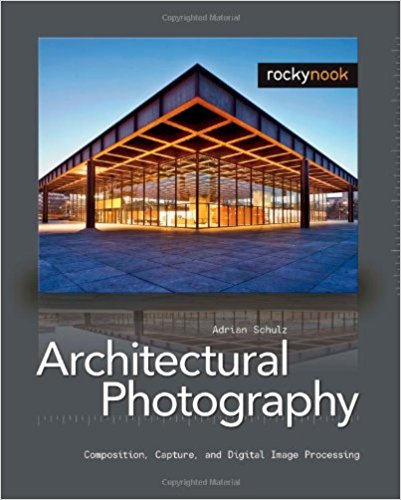Architectural Photography
writer: russell j.t. dyer; posted: aug 2009; revised: oct 2017; readers past month: 736
Review of Canon PowerShot G10

author: Adrian Schulz
edition: 1
published: 2009
publisher: Rocky Nook
isbn: 978-1933952048
pages: 232
Buy on Amazon
Adrian Schulz is a young man with a background in architecture and photography. He has brought together these two interests of his in a remarkable way with this book on architectural photography. Photographing a house, a building, or other structures such as a bridge may seem like a simple task — after all, they don’t move or hide from the camera. However, to do it in such a way so that the results are artistic and not just a boring shot of some structure, that takes artistic skills and know-how. In a clean writing style and a meticulous, no-fluff manner one would expect from an architect, Schulz presents this interesting field of photography.
Before going into the chapter highlights, let me say that this is a beautifully produced book. As usual, the publisher, Rocky Nook has done an excellent job of laying out this book and printing it. The collection of excellent photographs taken by Schulz that are presented in the book are pristinely reproduced and presented. Besides being a useful text for learning about photographing architecture, it can make for a nice coffee table book for photographers.
Chapter Highlights
There are only four chapters, but they are extensive chapters. In the first chapter, Schulz presents the history of architectural photography, starting with roots in art history. He predates the representation of architecture in two dimensional art back more than two thousand years. He gives interesting and more direct connections like the works of Bernardo Bellotto from the mid-18th century who painted very precise city scenes in Venice and other parts of Italy using a device called a camera obscura.
In the second chapter, Schulz discusses photography equipment. This may be an overdone topic in many photography books. However, for the topic of photographing architecture, there are some special aspects to consider. He assumes the reader has a basic understanding of photography concepts and focuses on the particulars of equipment as they relate to his topic. For instance, this isn’t a field generally conducive to long focal length, telephoto lenses. So talks about wide angle lenses and shift lenses. He also reviews accessories like lens filters and lens hoods. Again, these are components that come into play when photographing architecture about which the reader may not have thought. For much higher quality images, he presents arguments for using medium format and large format film cameras. He provides some interesting diagrams regarding digital image sensors and film formats that made me reconsider the use of film cameras after several years of working in digital, only.
Chapter Three is on shooting techniques and is the heart of the book; it makes up half of this 210 page long book — 20 by 25cm in size. Schulz explains what makes a photograph of a structure such as an office building art and not just a documentary photo (e.g., factors such as the subject, perspective, camera positioning). He provides many suggestions for improving and developing skills as an architectural photographer. He takes his time and discusses artistic methods for photographing architecture. He points out common problems with the vertical lines of large buildings converging, a bending of the image. He gives a few good suggestions and illustrations of how to solve this problem with converging lines. He discusses the positioning of the camera for different artistic effects; the effects of focal length on the results. He also points out how the reader should consider other objects in a shot: people, vehicles, and landscape.
Within the same chapter, Schulz has a section on shooting interiors. This can be tricky when constrained by small spaces. It’s also difficult to give an artistic or other feel (e.g., sophosticated or chic feel) to an interior shot. Schulz reviews these goals. He has another section on factors related to shooting buildings outside, factors such as weather, time of day, and season. He ends with a section providing creativity tips in this field of photography.
Like all photography books published lately, this one has a chapter on post processing of digital images with software. Schulz covers some of the basics on digital formats and RAW images. Besides discussing cropping as one might expect, Schulz extensively explains techniques for straightening of photos — another method for dealing with converging lines or image distortions due to photographing architecture with ultra-wide angle lenses.
Summary
This book is an interesting and easy read, albeit not necessarily for the novice. Even if you have no interest in specializing in architectural photography, though, you may want to get a copy of this book and at least give it a quick read through. You’ll be surprised by some of the things you’ll learn and when someone asks you to photograph their home or office, you’ll have a ready reference to prepare yourself for the shoot. Besides that, as I mentioned earlier, it’s a pleasure to flip through this book even for non-photographers and therefore makes a great book to leave in your waiting-room or on a coffee table at home. Your visitors will enjoy it and it can inspire conversations on photography — which I imagine is one of your favorite topics.